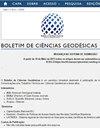基于类的高光谱图像亲和传播降维与最大似然分类精度的提高
IF 0.5
Q3 Earth and Planetary Sciences
引用次数: 3
摘要
摘要本文研究了一种将基于类的亲和传播(CAP)聚类算法和最大似然分类器(MLC)相结合的替代分类方法,旨在克服MLC在高维数据分类中的局限性,从而提高其准确性。该分类器被命名为CAP-MLC,包括光谱特征选择和图像分类两种方法。CAP聚类算法用于图像的降维和特征选择,MLC用于图像分类。MLC在分类精度和处理时间方面的性能被确定为CAP聚类阶段中实现的选择率的函数。使用机载可见红外成像光谱仪(AVIRIS)和高光谱数字图像采集实验(HYDICE)的两个高光谱场景对CAP-MLC的性能进行了评估和验证。分类结果表明,与MLC的85.42%和81.50%相比,CAP-MLC的AVIRIS和HYDICE的准确率分别达到94.15%和96.47%。CAP-MLC获得的这些值使这些图像的MLC分类准确率分别提高了8.73%和14.97%。结果还表明,即使对于训练样本有限的课程,CAP-MLC也表现良好,超过了MLC的限制。本文章由计算机程序翻译,如有差异,请以英文原文为准。
CLASS-BASED AFFINITY PROPAGATION FOR HYPERSPECTRAL IMAGE DIMENSIONALITY REDUCTION AND IMPROVEMENT OF MAXIMUM LIKELIHOOD CLASSIFICATION ACCURACY
Abstract This paper investigates an alternative classification method that integrates class-based affinity propagation (CAP) clustering algorithm and maximum likelihood classifier (MLC) with the purpose of overcome the MLC limitations in the classification of high dimensionality data, and thus improve its accuracy. The new classifier was named CAP-MLC, and comprises two approaches, spectral feature selection and image classification. CAP clustering algorithm was used to perform the image dimensionality reduction and feature selection while the MLC was employed for image classification. The performance of MLC in terms of classification accuracy and processing time is determined as a function of the selection rate achieved in the CAP clustering stage. The performance of CAP-MLC has been evaluated and validated using two hyperspectral scenes from the Airborne Visible Infrared Imaging Spectrometer (AVIRIS) and the Hyperspectral Digital Imagery Collection Experiment (HYDICE). Classification results show that CAP-MLC observed an enormous improvement in accuracy, reaching 94.15% and 96.47% respectively for AVIRIS and HYDICE if compared with MLC, which had 85.42% and 81.50%. These values obtained by CAP-MLC improved the MLC classification accuracy in 8.73% and 14.97% for these images. The results also show that CAP-MLC performed well, even for classes with limited training samples, surpassing the limitations of MLC.
求助全文
通过发布文献求助,成功后即可免费获取论文全文。
去求助
来源期刊

Boletim De Ciencias Geodesicas
Earth and Planetary Sciences-General Earth and Planetary Sciences
CiteScore
1.70
自引率
20.00%
发文量
10
审稿时长
3 months
期刊介绍:
The Boletim de Ciências Geodésicas publishes original papers in the area of Geodetic Sciences and correlated ones (Geodesy, Photogrammetry and Remote Sensing, Cartography and Geographic Information Systems).
Submitted articles must be unpublished, and should not be under consideration for publication in any other journal. Previous publication of the paper in conference proceedings would not violate the originality requirements. Articles must be written preferably in English language.
 求助内容:
求助内容: 应助结果提醒方式:
应助结果提醒方式:


